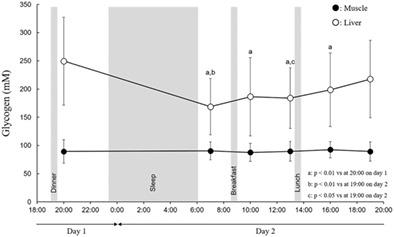当前位置:
X-MOL 学术
›
NMR Biomed.
›
论文详情
Our official English website, www.x-mol.net, welcomes your
feedback! (Note: you will need to create a separate account there.)
Diurnal variation in the glycogen content of the human liver using 13 C MRS.
NMR in Biomedicine ( IF 2.7 ) Pub Date : 2020-03-11 , DOI: 10.1002/nbm.4289 Kaito Iwayama 1 , Takahiro Onishi 2 , Katsuya Maruyama 3 , Hideyuki Takahashi 4
NMR in Biomedicine ( IF 2.7 ) Pub Date : 2020-03-11 , DOI: 10.1002/nbm.4289 Kaito Iwayama 1 , Takahiro Onishi 2 , Katsuya Maruyama 3 , Hideyuki Takahashi 4
Affiliation

|
Glycogen in tissues functions not only as carbohydrate reserves, but also as molecular sensors capable of activating signaling pathways in response to physical activity. While glycogen in the skeletal muscles is mainly a local energy substrate, glycogen in the liver serves as a glucose reserve to maintain normal blood glucose levels in the body, even during the sleep state. The aim of this study is to compare the diurnal variation of glycogen in the muscle and liver of human subjects under normal conditions. The glycogen content was measured in the muscle and liver of 10 young, healthy, male volunteers using 13 C MRS, a non-invasive technique. The subjects remained sedentary, and glycogen concentration was measured six times daily. Experimental meals were provided to achieve individual energy balance, estimated according to the energy requirement guideline for patients from Japan. The largest variation in muscle glycogen compared with 1 h after supper (20:00 on Day 1) was 3.1 ± 8.2 mmol/L (16:00 on Day 2). In the liver, however, the glycogen content decreased by 80.6 ± 40.4 mmol/L through the overnight fasting period (07:00 on Day 2). This study demonstrated that the glycogen content in the liver was significantly lower in the morning, while the glycogen content in the calf muscles underwent minimal diurnal variation. The overnight fast is a characteristic daily condition, in which liver glycogen content is low, whereas muscle glycogen content is relatively unaffected.
中文翻译:

使用13 C MRS,人肝糖原含量的日变化。
组织中的糖原不仅充当碳水化合物的储备,而且还具有能够响应身体活动而激活信号传导途径的分子传感器。骨骼肌中的糖原主要是局部能量底物,而肝脏中的糖原则是葡萄糖储备,即使在睡眠状态下也可以维持体内正常的血糖水平。这项研究的目的是比较正常条件下人类受试者肌肉和肝脏中糖原的昼夜变化。使用13 C MRS(一种非侵入性技术)测量了10位年轻,健康的男性志愿者的肌肉和肝脏中的糖原含量。受试者久坐不动,每天测量糖原浓度六次。提供实验餐以实现个人能量平衡,根据日本患者的能量需求指南估算。与晚餐后1小时(第1天20:00)相比,肌肉糖原的最大变化为3.1±8.2 mmol / L(第2天16:00)。然而,在肝脏中,整个禁食过夜(第2天的07:00)的糖原含量降低了80.6±40.4 mmol / L。这项研究表明,早晨肝脏中的肝糖原含量显着降低,而小腿肌肉中的肝糖原含量昼夜变化最小。过夜禁食是典型的日常状况,其中肝糖原含量低,而肌肉糖原含量相对不受影响。然而,在整个禁食期(第2天的07:00),糖原含量降低了80.6±40.4 mmol / L。这项研究表明,早晨肝脏中的肝糖原含量显着降低,而小腿肌肉中的肝糖原含量昼夜变化很小。过夜禁食是典型的日常状况,其中肝糖原含量低,而肌肉糖原含量相对不受影响。然而,在整个禁食期(第2天的07:00),糖原含量降低了80.6±40.4 mmol / L。这项研究表明,早晨肝脏中的肝糖原含量显着降低,而小腿肌肉中的肝糖原含量昼夜变化很小。整夜禁食是典型的日常状况,其中肝糖原含量低,而肌肉糖原含量相对不受影响。
更新日期:2020-03-11
中文翻译:

使用13 C MRS,人肝糖原含量的日变化。
组织中的糖原不仅充当碳水化合物的储备,而且还具有能够响应身体活动而激活信号传导途径的分子传感器。骨骼肌中的糖原主要是局部能量底物,而肝脏中的糖原则是葡萄糖储备,即使在睡眠状态下也可以维持体内正常的血糖水平。这项研究的目的是比较正常条件下人类受试者肌肉和肝脏中糖原的昼夜变化。使用13 C MRS(一种非侵入性技术)测量了10位年轻,健康的男性志愿者的肌肉和肝脏中的糖原含量。受试者久坐不动,每天测量糖原浓度六次。提供实验餐以实现个人能量平衡,根据日本患者的能量需求指南估算。与晚餐后1小时(第1天20:00)相比,肌肉糖原的最大变化为3.1±8.2 mmol / L(第2天16:00)。然而,在肝脏中,整个禁食过夜(第2天的07:00)的糖原含量降低了80.6±40.4 mmol / L。这项研究表明,早晨肝脏中的肝糖原含量显着降低,而小腿肌肉中的肝糖原含量昼夜变化最小。过夜禁食是典型的日常状况,其中肝糖原含量低,而肌肉糖原含量相对不受影响。然而,在整个禁食期(第2天的07:00),糖原含量降低了80.6±40.4 mmol / L。这项研究表明,早晨肝脏中的肝糖原含量显着降低,而小腿肌肉中的肝糖原含量昼夜变化很小。过夜禁食是典型的日常状况,其中肝糖原含量低,而肌肉糖原含量相对不受影响。然而,在整个禁食期(第2天的07:00),糖原含量降低了80.6±40.4 mmol / L。这项研究表明,早晨肝脏中的肝糖原含量显着降低,而小腿肌肉中的肝糖原含量昼夜变化很小。整夜禁食是典型的日常状况,其中肝糖原含量低,而肌肉糖原含量相对不受影响。











































 京公网安备 11010802027423号
京公网安备 11010802027423号